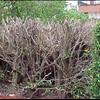This plant may be available to buy
Click the banana to see

|
Not all hedge plants |
| Quiz:
What is overwhelmingly the most "popular" hedge plant? ...and what is, without a doubt, the ABSOLUTE WORST hedge material you could plant? If you answered FICUS, you are right (Ficus benjamina, Weeping Fig) Ficus is the most popular hedge plant for the following very poor reasons:
So, Master Gardener, what's the problem using ficus? .
Glad you asked Most hedge plants are really trees, but ficus happens to be a VERY VERY LARGE TREE After you plant ficus, the plant doesn't "turn into" a hedge. It KNOWS it's a tree.....a VERY VERY LARGE TREE and tries to grow to it's full size
click photo above to see what a What's full size for a SINGLE ficus plant? Ohhhhhhh, an acre or two !!! The largest ficus in the world is in India and covers over 550 acres of land !!! One plant !!! So, in your landscape, you trim your ficus to shape, but the ficus roots still know it's a tree. Even though you cut the top, the trunk and roots try to become full sized trees After a few years, your soil is totally invaded by ficus tree roots. Virtually nothing will grow at the base of larger ficus trees. Removal is out of the question in most situations. The best you could do is cut them down and grind the stumps...leaving the massive roots in the soil Worse, the expense to trim the ficus hedge grows every year. You actually have to "defend yourself" from ficus growth. Coarse wood and coarse leaves, not soft foliage like this podocarpus Older larger hedges may a require 3-4 men working for several hours 2X a month to keep the ficus hedge in bounds. You could be spending $125-$250 a month just trying to control your ficus hedge Does that still sound like a bargain hedge to you? No way For this reason, ficus actually becomes THE MOST EXPENSIVE hedge you can plant !!! Writing for THE TROPICAL GARDEN published by FAIRCHILD TROPICAL GARDEN, Jeff Wasielewski writes about a major new reason not to plant ficus hedge: The Ficus Whitefly (Singhiella simplex) Jeff notes this pest has "laid waste to the South Florida landscape by quickly and efficiently skeletonizing ficus hedges of all shapes and sizes. A second [ficus] pest is the weeping fig thrip (Cynaikothrips uzeli). The weeping fig thrip feeds on new leaves and causes unsightly galls and noticeable leaf curl. The two pests, in combination, are devestating. Together these pests can defoliate a ficus hedge in a matter of weeks. With all the problems associated with the traditional ficus hedge, it is time to say farewell to ficus" And finally, ficus is the most unkempt looking hedge The reason is, again, it's exceedingly fast growth. Trim your ficus hedge and --- in a few days or a week --- your ficus hedge already has excess growth on top and sides. Ficus only looks neat and clean a few days after pruning. During fall/winter growth slows so the appearance is better, but spring/summer, new growth appears immediately, spoiling the clean look you want OK, OK, some people still want ficus for some landscape applications, where LARGE is good. If you like a large formal look or need a massive entrance hedge, ficus may be what you want
Hedge plants are quoted by growers as 3-gallon plants. In some cases, 7-gallon plants are available, but totally uneconomical for you. Prices go up dramatically for 7-gallon pots, 3-5x common 3-gallon pots |
